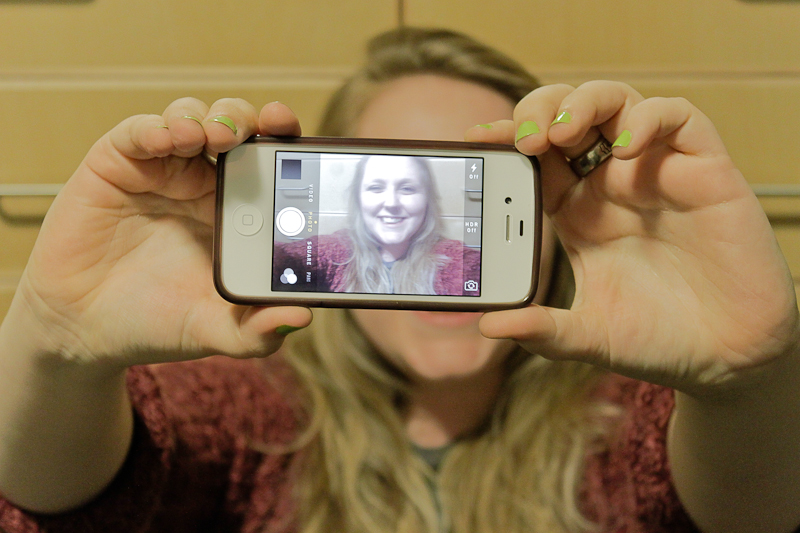You’ve probably done it before—sat in front of your computer, tilted your head, questioned your motives, snapped a photo and bam—you became part of the selfie generation.
It certainly seems like we have an innate fascination with the concept of ourselves, one that harkens way back in history before poet Walt Whitman was ever celebrating and singing.
You’ve probably done it before—sat in front of your computer, tilted your head, questioned your motives, snapped a photo, and bam—you became part of the selfie generation.
It certainly seems like we have an innate fascination with the concept of ourselves, one that harkens way back in history before poet Walt Whitman was ever celebrating and singing.
But never has this been more prominent than within the last few years with the introduction of the selfie. Cameras are everywhere from our computers to our phones and it’s easy to snap a quick shot of your face.
Is this new era of self-portraiture calling out the underlying voices of a narcissistic society? Or is the selfie becoming a new genre of photography, and even art?
Selfie indulgence?
Andrew Cohen, a Carleton University journalism professor, explained the selfie as an expression of “the age of the self.”
“We are likely to say in a way that other generations weren’t, that every child’s a winner . . . and no matter what you do, everyone should win a trophy,” he said.
Cohen said there’s a constant struggle between significant and insignificant images side by side online.
“We’re just swimming in kind of a trivia of insignificance where everybody thinks they have a story. And that their story is equally of interest,” he said.
Cohen said the selfie is an expression of self gratification and self assesment particularly in young people.
“The reason that the selfie has become what it is, is because we’re not ashamed to talk about ourselves, to celebrate ourselves,” he said. “People are interested in how much other people like them.”
Cohen said the selfie is an embodiment of a larger idea in society. He pointed to Rob Ford’s recent media mishaps as an example of an attention-seeking culture.
“For him to go on Jimmy Kimmel is a reflection of the ego. And I think we see more and more of that,” he said. “There was a time where people in public life felt shame or a certain sense of self-awareness.”
He referenced a time after World War II as an extreme example of the contrast between the present day idea of selling yourself and your own image to the world all of the time, and the past ideal of keeping things confined to private life.
“In the same way today we have an instinct to talk about ourselves, they had the opposite instinct then. They didn’t want to talk about it,” Cohen explained. “We have had a remarkable reversal in how we see ourselves.”
Cohen said he thinks moderation is crucial when it comes to social media.
“I mean if people want to post what they had for dinner, if anyone’s interested, fine. I guess that’s not harmful,” he said. “What I worry about is it embedding and creating a society in which we’re all indulgent.”
Snapshots of the past
Aubrey Anable, a professor of cinema studies at the University of Toronto, said the history of photography and the idea of selfies goes back to the early 20th century.
She said there’s always been a fascination in self portraiture but the one characteristic separating past self portraits and today’s selfies is the medium of sharing on a digital platform.
“I think sharing is the key here. That’s what’s new, not so much the selfie itself,” Anable said.
Dwayne Brown, professional photographer and creator of the street protrait project loveOttawa, also spoke of the rich history of self portraiture.
“Self portraits have always been around, photographers have always done them. There was a photographer Duane Michaels, and he was big in the ‘60s and ‘70s . . . he almost always took self portraits . . . they were totally an art form,” he said.
With this new mode of sharing, Brown said there may be an underlying need for self-assurance.
“At the end of the day . . . there’s a lot of narcissism involved too because it’s all about sharing it,” he said. “You can kind of engage in that electronic kind of social media domain. It’s a bit shallow if that’s all you’re ever going to do.”
Anable said she thinks narcissism is a part of human nature, and not a singular constitution for selfie taking.
“I think we’ve always been sort of narcissistic, and we certainly have more forms and technologies to, sort of, display that . . . but I also think that it’s a way of asserting our self and our own images into a larger visual landscape,” she said. “I do think selfies can reinforce the ideas in society about body image especially in young people.”
The face in the mirror
Linda Buchan, registered psychologist at TwelveTwo Counselling in Calgary, said there is a reason for the popularity of selfies in a younger age demographic.
“This developmental period in the life of a teenager or young adult is marked by identity formation and the search for independence (emancipation). Selfies allow for exploration of identity and create opportunities to test that identity,” she said via email.
Anable said she often thinks of selfies in the context of teenage desires and anxieties.
“I can’t help but wonder if I would be producing and sharing a lot of selfies if I were, you know a 15-year-old girl . . . I grew up in a time where I certainly took pictures of myself, but didn’t have the internet to share those pictures. So I think there is something about the anxieties and desires of teenagers . . . that make the whole selfie culture appealing,” she explained.
“[Selfies are] a complicated cultural practise. Certainly narcissism is a part of it, but we can’t just stop there,” she said. “I also think that selfies can be empowering.”
Brown said though the notion of selfies is emphasized through social media, the practise is not necessarily a testament to today’s generation. He said to young people this trend is simply a social norm.
“You’ve grown up with it being very, very normal,” he said. “I think the older generation tends to push it away, or think it’s not as important as it is, or that it shouldn’t be happening, and I don’t know. Regardless of your generation, regardless of your past experiences, regardless of what you think, things are going to move forward.”
Selfies and the art of photography
Brown said the constant access to better technology in the quality of cameras is starting to provide a platform to a growing community of photographers, and this explains the burgeoning popularity of self-portraiture as well.
“Photography has gotten extremely accessible,” Brown said. “There was a time when an art director wanted a photo of say a water glass on a table . . . something as simple as that, he would call a photographer to come take a shot of a glass of water on a table.”
Brown pointed out that selfies are far from the only trend spreading through social media.
“There’s probably more cats on Instagram than selfies,” he laughed. He said he sees the accessibility of cameras today as a positive thing overall.
Anable said the practice of selfies has become an evolving artistic language.
“There are certain poses and angles that appear again and again. I don’t know if I would say that is a new art form, but I wouldn’t rule it out,” she said. “I also think the selfie . . . is part of this history of photography. It doesn’t detract from it. It’s just adding another aspect.”
“So much of what we encounter in our daily lives are images of other people, so why wouldn’t we want to also insert ourselves into that visual conversation?” Anable said.
Celebrating and singing yourself
The selfie with the most traffic, of thousands of selfies online, came with the now iconic group selfie taken at the Oscars by Ellen DeGeneres. While an argument can be made saying it was part of a bigger marketing plan, Brown said there was a significant aspect of the photo that made people feel connected to it.
“The reason it’s such a great shot is that when you look at each of these people in that shot, they look like regular people,” he said.
Brown said selfies speak to a larger theme of interconnectedness, as we indulge in the fact that we’re all human and like sharing pieces of ourselves and our lives with each other.
“It’s not just about fun, it’s about moving ideas around, sharing stories, sharing news,” he said.
Buchan said she thinks self-portraiture can be a form of self validation.
“We take pleasure in stealing a glance at our reflection, validating our existence in the world,” she said. “The possibilities likely are as vast as the creative expressions of the selfie: anything from preserving a special moment, to trying on a new identity to posting a status update.”
She mentioned the ability to create an identity through sharing online.
“I believe young people gravitate to anything that is unique to them,” she said. “Staking a claim on personal identity in an age where there is information overload may be a piece of the puzzle. We all have a need to be known.”
Reporter Oliver Sachgau takes to Carleton campus to quiz students about their selfie habits.






